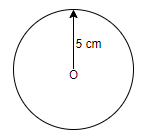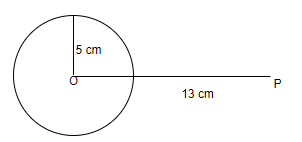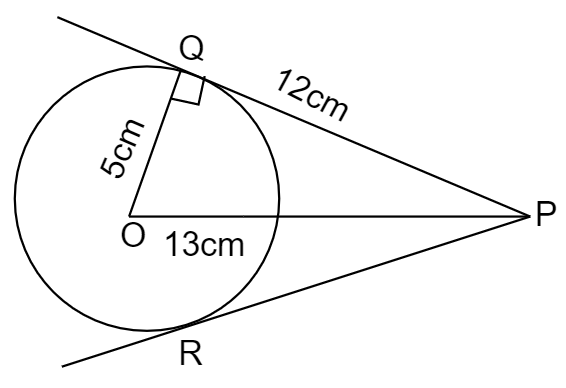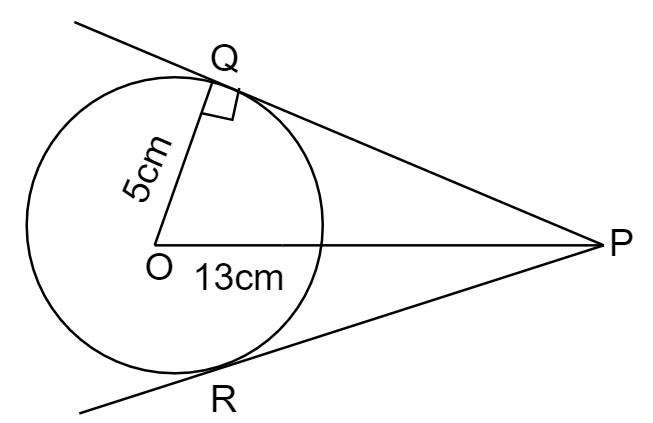
Draw a circle of radius 5cm. From a point 13cm away from the centre, construct a pair of tangents to the circle and measure their length. Also verify the measurement by actual calculation.
Answer
519.6k+ views
Hint: We need to construct a pair of tangents to a circle and find their length. We start to solve the given question by constructing a circle of radius 5cm with centre O and draw a line segment OP of length 13cm. Then, we need to find the length of the tangent of the circle. Lastly, we verify the length of the tangent to a circle by actual calculation.
Complete step by step solution:
We are asked to draw a circle of radius 5 cm and need to construct tangents for the same. We will be solving the given question by constructing a circle of radius 5 cm and then finding the length of tangents to the circle.
The tangent to the circle is defined as the straight line that touches a circle at exactly one point. The point of contact where a tangent meets the circle is called tangency or point of contact. There can be only one tangent to a circle at a given point.
The pair of tangents to a circle can be constructed as follows,
1. We need to draw a circle of radius 5cm with centre O using a compass and pencil. So, we can take 5 cm on the compass and draw the circle as below,

2.Draw a line segment OP of length 13 cm from the centre of the circle to P.

3. Join point P to any point Q on the circle such that PQ touches the circle.
After the steps, we find that the length of PQ is 12 cm with the help of a ruler.

Actual calculation:
The above steps can be diagrammatically represented as follows,

In the above figure,
PQ and PR are the pair of tangents to a circle.
We need to find the length of tangents PQ, PR.
From the figure,
We know that a triangle $OQP$ is a right-angled triangle.
Applying the Pythagoras theorem to the triangle, we get,
$\Rightarrow O{{P}^{2}}=O{{Q}^{2}}+P{{Q}^{2}}$
Here,
$OP=13cm$ ;
$OQ=5cm$
Substituting the same, we get,
$\Rightarrow {{13}^{2}}={{5}^{2}}+P{{Q}^{2}}$
Simplifying the above equation, we get,
$\Rightarrow 169=25+P{{Q}^{2}}$
$\Rightarrow 169-25=P{{Q}^{2}}$
$\Rightarrow 144=P{{Q}^{2}}$
$\Rightarrow PQ=\sqrt{144}$
$\Rightarrow PQ=\pm 12$
The length of a tangent cannot be negative.
$\therefore PQ=12$
$\therefore$ The length of tangents in both cases is the same.
Note: We need to precisely measure the length of the sides with the ruler. We must remember that the value of $\sqrt{{{a}^{2}}}=\pm a$ and not $+a$ . Pythagoras Theorem defines the relationship between the three sides of a triangle. It states that the square of the hypotenuse of the right-angled triangle is equal to the sum of the squares of the other two sides of a triangle.
Complete step by step solution:
We are asked to draw a circle of radius 5 cm and need to construct tangents for the same. We will be solving the given question by constructing a circle of radius 5 cm and then finding the length of tangents to the circle.
The tangent to the circle is defined as the straight line that touches a circle at exactly one point. The point of contact where a tangent meets the circle is called tangency or point of contact. There can be only one tangent to a circle at a given point.
The pair of tangents to a circle can be constructed as follows,
1. We need to draw a circle of radius 5cm with centre O using a compass and pencil. So, we can take 5 cm on the compass and draw the circle as below,

2.Draw a line segment OP of length 13 cm from the centre of the circle to P.

3. Join point P to any point Q on the circle such that PQ touches the circle.
After the steps, we find that the length of PQ is 12 cm with the help of a ruler.

Actual calculation:
The above steps can be diagrammatically represented as follows,

In the above figure,
PQ and PR are the pair of tangents to a circle.
We need to find the length of tangents PQ, PR.
From the figure,
We know that a triangle $OQP$ is a right-angled triangle.
Applying the Pythagoras theorem to the triangle, we get,
$\Rightarrow O{{P}^{2}}=O{{Q}^{2}}+P{{Q}^{2}}$
Here,
$OP=13cm$ ;
$OQ=5cm$
Substituting the same, we get,
$\Rightarrow {{13}^{2}}={{5}^{2}}+P{{Q}^{2}}$
Simplifying the above equation, we get,
$\Rightarrow 169=25+P{{Q}^{2}}$
$\Rightarrow 169-25=P{{Q}^{2}}$
$\Rightarrow 144=P{{Q}^{2}}$
$\Rightarrow PQ=\sqrt{144}$
$\Rightarrow PQ=\pm 12$
The length of a tangent cannot be negative.
$\therefore PQ=12$
$\therefore$ The length of tangents in both cases is the same.
Note: We need to precisely measure the length of the sides with the ruler. We must remember that the value of $\sqrt{{{a}^{2}}}=\pm a$ and not $+a$ . Pythagoras Theorem defines the relationship between the three sides of a triangle. It states that the square of the hypotenuse of the right-angled triangle is equal to the sum of the squares of the other two sides of a triangle.
Recently Updated Pages
Master Class 9 Social Science: Engaging Questions & Answers for Success

Master Class 9 Science: Engaging Questions & Answers for Success

Master Class 9 English: Engaging Questions & Answers for Success

Master Class 9 Maths: Engaging Questions & Answers for Success

Master Class 9 General Knowledge: Engaging Questions & Answers for Success

Class 9 Question and Answer - Your Ultimate Solutions Guide

Trending doubts
Which places in India experience sunrise first and class 9 social science CBSE

Fill the blanks with the suitable prepositions 1 The class 9 english CBSE

Write the 6 fundamental rights of India and explain in detail

Difference Between Plant Cell and Animal Cell

What is pollution? How many types of pollution? Define it

What is the Full Form of ISI and RAW




